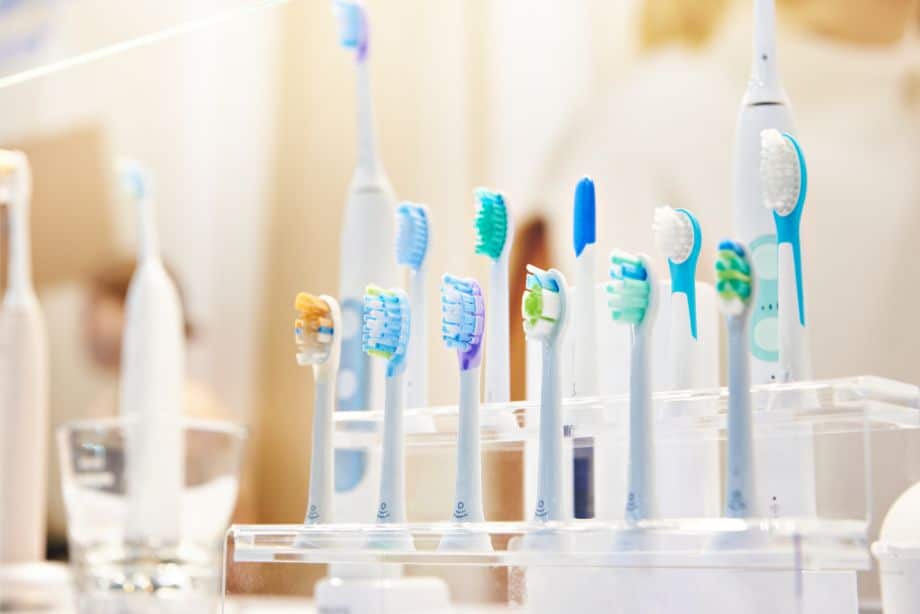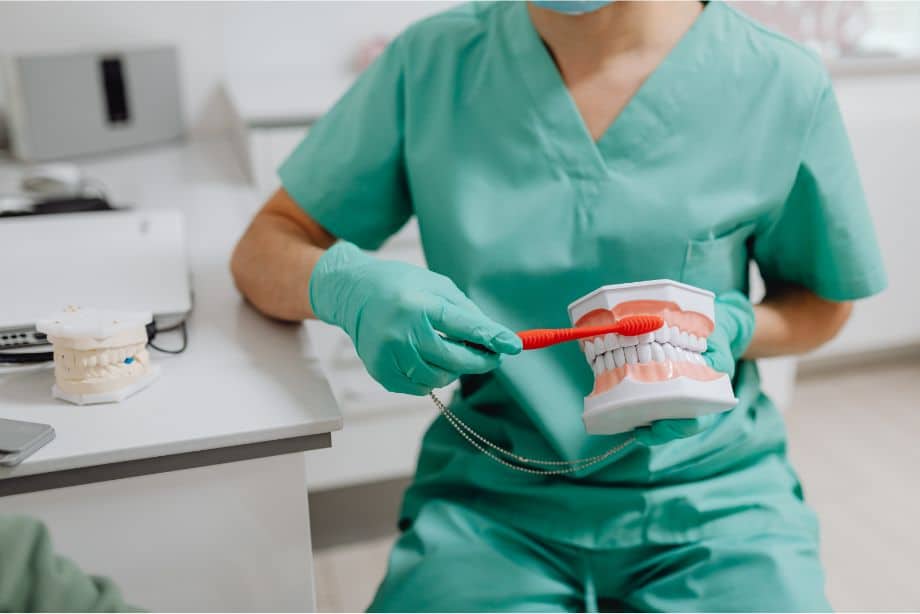Brushing your teeth properly is one of the most effective ways to protect your oral health. But are you using the correct technique? From the type of toothbrush you choose to how long you spend brushing, small changes can make a big difference in maintaining a healthy smile.
This guide from Hamilton Dental Centre will help you master brushing basics – perfect for children, adults, and anyone looking to improve their dental care routine.
What Type of Toothbrush Should I Use?
A soft-bristled toothbrush is usually best because it effectively cleans teeth without damaging gums or enamel.
When choosing a toothbrush, size and comfort matter as much as bristle type. A smaller brush head allows you to reach the back teeth more easily. Both manual and electric toothbrushes can be effective, but electric options often make brushing easier and more consistent.
Tips for choosing a toothbrush:
- Bristle type: Always opt for soft bristles unless advised otherwise by your dentist.
- Size: Select a head size that comfortably fits your mouth.
- Electric vs manual: Electric brushes are especially useful for children, older adults, or those with limited dexterity.

Which Toothpaste Is Best for My Needs?
Fluoride toothpaste is essential for protecting enamel and preventing cavities, but you may need a special formula depending on your dental needs.
For example, if you have sensitive teeth, choose a desensitising toothpaste. Whitening formulas can help reduce surface stains, while children need lower-fluoride options designed for their age.
Toothpaste options include:
- Fluoride toothpaste: Strengthens enamel and prevents tooth decay.
- Whitening toothpaste: Reduces stains for a brighter smile.
- Sensitive formulas: Minimise discomfort when eating or drinking hot and cold foods.
- Children’s toothpaste: Lower fluoride concentration for safe daily use.
How Should You Brush Your Teeth Properly?
Brush at a 45-degree angle to your gums, using gentle circular motions for two minutes, twice a day.
Correct technique ensures you clean every surface of every tooth. Remember that rushing or brushing incorrectly leaves plaque behind, increasing the risk of cavities and gum disease.
Step-by-step brushing technique:
- Position your toothbrush: Hold it at a 45-degree angle against the gum line.
- Outer surfaces: Use gentle, circular motions.
- Inner surfaces: Tilt the brush vertically and brush with short strokes.
- Chewing surfaces: Use back-and-forth motions to remove food particles.
- Tongue and roof of mouth: Gently clean these areas to reduce bacteria and freshen breath.
Tip: Avoid aggressive brushing – it can wear away enamel and irritate your gums.

How Long Should You Brush Your Teeth?
Dentists recommend brushing for two minutes, twice daily.
That’s the gold standard for effective plaque removal and gum health, and ensures every tooth gets enough attention and reduces the risk of missing problem areas. To keep track, try using a timer, an electric toothbrush with a built-in timer, or even playing a two-minute song.
Bonus: Try splitting your mouth into four quadrants and spend 30 seconds on each to ensure even cleaning.
What Are the Most Common Brushing Mistakes?
Brushing too hard, rushing, or forgetting certain areas are the most common mistakes.
Overbrushing can erode enamel and irritate gums, while underbrushing leaves harmful plaque behind. Many people also forget to clean the inner surfaces of their teeth or their tongue.
Mistakes to avoid:
- Brushing too hard (causes gum recession).
- Holding your toothbrush horizontally instead of angled.
- Neglecting the back teeth and gum line.
- Forgetting to replace your toothbrush every 3–4 months.
Quick Fix: Focus on being thorough, not forceful.

Is Brushing Enough for Good Oral Hygiene?
No, brushing alone isn’t enough. You should also floss daily, use mouthwash, and see your dentist regularly.
Brushing is the foundation of oral care, but flossing removes plaque between teeth that brushes can’t reach, and mouthwash kills bacteria to freshen breath. Regular check-ups help catch issues early and maintain long-term oral health.
Additional oral care tips:
- Floss Daily: Removes plaque and debris between teeth.
- Use Mouthwash: Antibacterial rinses help reduce plaque and freshen breath.
- Limit Sugary Foods: Sugar feeds harmful bacteria in your mouth.
- Stay Hydrated: Drinking water helps wash away food particles and bacteria.
- Routine Dental Check-ups: Professional cleanings catch issues early and keep your mouth healthy.
What’s the Best Way to Teach Kids to Brush?
Make brushing fun, consistent, and age-appropriate. Teaching children good brushing habits early sets the foundation for lifelong oral health.
Brushing Tips for Kids
- Use child-sized brushes with soft bristles.
- Introduce fluoride toothpaste when they’re able to spit it out.
- Supervise brushing until at least age 7–8.
- Use timers, songs, or brushing apps to keep them engaged.
- Reward consistent brushing habits with stickers or small incentives.
How Can I Tell If I’m Brushing Effectively?
Look for clean, smooth teeth and healthy pink gums. If your mouth still feels unclean or you notice bleeding gums, your technique may need improvement.
Signs of Good Brushing
- No visible plaque or food debris
- Fresh breath
- No gum bleeding (unless just starting flossing)
- Smooth-feeling teeth
If you’re unsure, ask your dentist for feedback during your next check-up.
FAQs: Brushing and Oral Hygiene
How often should I brush my teeth?
You should brush at least twice a day – once in the morning and once before bed.
Can I brush too much?
Yes. Overbrushing, especially with excessive force, can wear down enamel and damage your gums.
What’s the best toothbrush for sensitive gums?
A soft-bristled brush, preferably electric, is gentle yet effective for sensitive gums.
Is flossing really necessary?
Absolutely. Brushing only cleans 60% of your tooth surfaces. Flossing removes plaque between teeth where brushes can’t reach.
Should I brush before or after breakfast?
Brush before breakfast to remove overnight bacteria. If brushing after, wait at least 30 minutes, especially if you’ve consumed acidic foods or drinks.
How can I get my child excited about brushing?
Make it a game, use apps, let them choose their toothbrush, and brush together as a family.
How often should I change my toothbrush?
Replace your toothbrush or electric brush head every 3–4 months, or sooner if the bristles are frayed.
Should I rinse my mouth after brushing?
Dentists recommend spitting, not rinsing. This allows fluoride from your toothpaste to stay on your teeth longer for maximum protection.
Can children use adult toothpaste?
Children under six should use age-appropriate toothpaste with lower fluoride levels to avoid swallowing too much fluoride.
Conclusion
Encouraging proper brushing habits at every age is essential for maintaining a healthy smile. By following these steps and integrating them into your daily routine, you can ensure effective oral hygiene. Remember, a healthy mouth contributes to your overall health, so make brushing a priority every day.
For more dental care tips and personalised advice, don’t hesitate to get in touch with the team at Hamilton Dental Centre. Happy brushing!
Feel free to share this guide with friends and family to promote better brushing habits for everyone!
Site map
Services
Contact Us
T: 07 854 8905
E: info@thehdc.co.nz
3/111 Thomas Road,
Rototuna, Hamilton
copyright © 2025 Hamilton Dental Centre | Credit Terms | Web development by Digital Hothouse

